作业1 客源国概况(双语)埃及
客源国
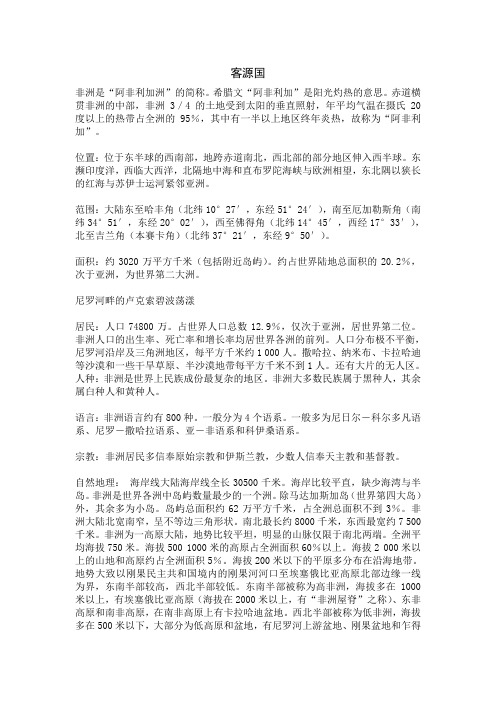
客源国非洲是“阿非利加洲”的简称。
希腊文“阿非利加”是阳光灼热的意思。
赤道横贯非洲的中部,非洲3/4的土地受到太阳的垂直照射,年平均气温在摄氏20度以上的热带占全洲的95%,其中有一半以上地区终年炎热,故称为“阿非利加”。
位置:位于东半球的西南部,地跨赤道南北,西北部的部分地区伸入西半球。
东濒印度洋,西临大西洋,北隔地中海和直布罗陀海峡与欧洲相望,东北隅以狭长的红海与苏伊士运河紧邻亚洲。
范围:大陆东至哈丰角(北纬10°27′,东经51°24′),南至厄加勒斯角(南纬34°51′,东经20°02′),西至佛得角(北纬14°45′,西经17°33′),北至吉兰角(本赛卡角)(北纬37°21′,东经9°50′)。
面积:约3020万平方千米(包括附近岛屿)。
约占世界陆地总面积的20.2%,次于亚洲,为世界第二大洲。
尼罗河畔的卢克索碧波荡漾居民:人口74800万。
占世界人口总数12.9%,仅次于亚洲,居世界第二位。
非洲人口的出生率、死亡率和增长率均居世界各洲的前列。
人口分布极不平衡,尼罗河沿岸及三角洲地区,每平方千米约1 000人。
撒哈拉、纳米布、卡拉哈迪等沙漠和一些干旱草原、半沙漠地带每平方千米不到1人。
还有大片的无人区。
人种:非洲是世界上民族成份最复杂的地区。
非洲大多数民族属于黑种人,其余属白种人和黄种人。
语言:非洲语言约有800种。
一般分为4个语系。
一般多为尼日尔-科尔多凡语系、尼罗-撒哈拉语系、亚-非语系和科伊桑语系。
宗教:非洲居民多信奉原始宗教和伊斯兰教,少数人信奉天主教和基督教。
自然地理:海岸线大陆海岸线全长30500千米。
海岸比较平直,缺少海湾与半岛。
非洲是世界各洲中岛屿数量最少的一个洲。
除马达加斯加岛(世界第四大岛)外,其余多为小岛。
岛屿总面积约62万平方千米,占全洲总面积不到3%。
非洲大陆北宽南窄,呈不等边三角形状。
埃及介绍英文版
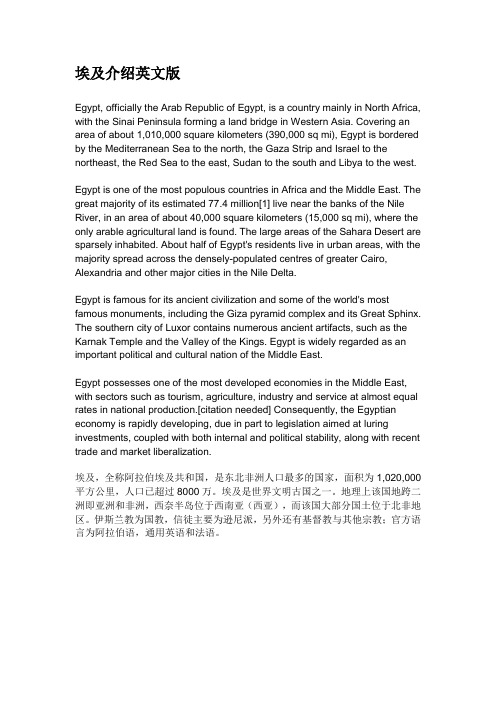
埃及介绍英文版Egypt, officially the Arab Republic of Egypt, is a country mainly in North Africa, with the Sinai Peninsula forming a land bridge in Western Asia. Covering an area of about 1,010,000 square kilometers (390,000 sq mi), Egypt is bordered by the Mediterranean Sea to the north, the Gaza Strip and Israel to the northeast, the Red Sea to the east, Sudan to the south and Libya to the west.Egypt is one of the most populous countries in Africa and the Middle East. The great majority of its estimated 77.4 million[1] live near the banks of the Nile River, in an area of about 40,000 square kilometers (15,000 sq mi), where the only arable agricultural land is found. The large areas of the Sahara Desert are sparsely inhabited. About half of Egypt's residents live in urban areas, with the majority spread across the densely-populated centres of greater Cairo, Alexandria and other major cities in the Nile Delta.Egypt is famous for its ancient civilization and some of the world's most famous monuments, including the Giza pyramid complex and its Great Sphinx. The southern city of Luxor contains numerous ancient artifacts, such as the Karnak Temple and the Valley of the Kings. Egypt is widely regarded as an important political and cultural nation of the Middle East.Egypt possesses one of the most developed economies in the Middle East, with sectors such as tourism, agriculture, industry and service at almost equal rates in national production.[citation needed] Consequently, the Egyptian economy is rapidly developing, due in part to legislation aimed at luring investments, coupled with both internal and political stability, along with recent trade and market liberalization.埃及,全称阿拉伯埃及共和国,是东北非洲人口最多的国家,面积为1,020,000平方公里,人口已超过8000万。
旅游客源国:埃及
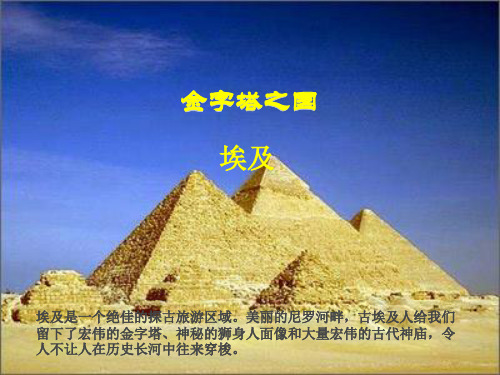
爱资哈尔大学 世界上最古老的高等学校之一,建于972年,为伊斯兰世界
规模最大、地位最高、享有盛名的宗教大学。 爱资哈尔大 学自古以来对培养造就穆斯林人才、传播伊斯兰思想和学 术文化作出了巨大贡献,成为世界穆斯林有志之士学习深 造的园地,它在伊斯兰教育和学术文化方面有较高的地位 和威望,被誉为“世界伊斯兰学术文化的灯塔和朝向”。
历史名人
塔哈· 侯赛因(1889.11.14-
1973.10.28) 是阿拉伯埃及现
代著名作家、文学家、文艺 批评家,也是一位思想家。 他的著述丰富,是个多产作 家。他不仅对文学,而且对
历史、哲学等都有精深的研
究,成为一代文宗,被人们 誉为“阿拉伯文学泰斗”。
代表作:《论蒙昧时代的诗歌》 《日子》
民族:阿拉伯人约占87%,科普特人约占11.8%,另有贝
都因人和努比亚人等
时差:比格林尼治时间早2h,比北京时间晚6h
行政区划:全国划分为27个省,省下设县、市、区、村
国旗于1984年10月4日启用。红色代表革命和鲜血,白色
代表光明的未来,黑色代表受外国压抑的长久历史。
国徽称为“萨拉丁之鹰”,注视西方的金黄色雄鹰象征日益
中大量的精美浮雕壁画,
栩栩如生的描绘了古代埃 及人工作和生活的情景。
另外,附近的神牛墓也非
常有名。
狮身人面像
狮身人面像或称人面狮身像,是一座位在卡夫拉金字塔旁的雕像,外 型是一个狮子的身躯和人的头。狮身人面像长约73.5米(241英尺), 宽约 6 米(20 英尺)和高约 20.22 米(66.34 英尺)。 狮身人面像是现 今已知最古老的纪念雕像,一般相信是在法老哈夫拉统治期间内建成 (约公元前 2558 年至 2532 年)。 1979 年根据被列入《世界遗产目录》。 1998年5月25日,埃及修复狮身人面像。
客源国概况较完整版
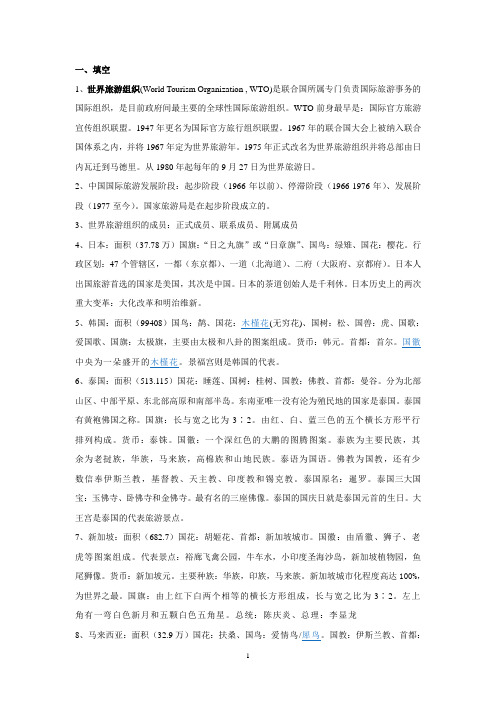
一、填空1、世界旅游组织(World Tourism Organization , WTO)是联合国所属专门负责国际旅游事务的国际组织,是目前政府间最主要的全球性国际旅游组织。
WTO前身最早是:国际官方旅游宣传组织联盟。
1947年更名为国际官方旅行组织联盟。
1967年的联合国大会上被纳入联合国体系之内,并将1967年定为世界旅游年。
1975年正式改名为世界旅游组织并将总部由日内瓦迁到马德里。
从1980年起每年的9月27日为世界旅游日。
2、中国国际旅游发展阶段:起步阶段(1966年以前)、停滞阶段(1966-1976年)、发展阶段(1977-至今)。
国家旅游局是在起步阶段成立的。
3、世界旅游组织的成员:正式成员、联系成员、附属成员4、日本:面积(37.78万)国旗:“日之丸旗”或“日章旗”、国鸟:绿雉、国花:樱花。
行政区划:47个管辖区,一都(东京都)、一道(北海道)、二府(大阪府、京都府)。
日本人出国旅游首选的国家是美国,其次是中国。
日本的茶道创始人是千利休。
日本历史上的两次重大变革:大化改革和明治维新。
5、韩国:面积(99408)国鸟:鹊、国花:木槿花(无穷花)、国树:松、国兽:虎、国歌:爱国歌、国旗:太极旗,主要由太极和八卦的图案组成。
货币:韩元。
首都:首尔。
国徽中央为一朵盛开的木槿花。
景福宫则是韩国的代表。
6、泰国:面积(513.115)国花:睡莲、国树:桂树、国教:佛教、首都:曼谷。
分为北部山区、中部平原、东北部高原和南部半岛。
东南亚唯一没有沦为殖民地的国家是泰国。
泰国有黄袍佛国之称。
国旗:长与宽之比为3∶2。
由红、白、蓝三色的五个横长方形平行排列构成。
货币:泰铢。
国徽:一个深红色的大鹏的图腾图案。
泰族为主要民族,其余为老挝族,华族,马来族,高棉族和山地民族。
泰语为国语。
佛教为国教,还有少数信奉伊斯兰教,基督教、天主教、印度教和锡克教。
泰国原名:暹罗。
泰国三大国宝:玉佛寺、卧佛寺和金佛寺。
《客源国概况》模拟试卷(二)
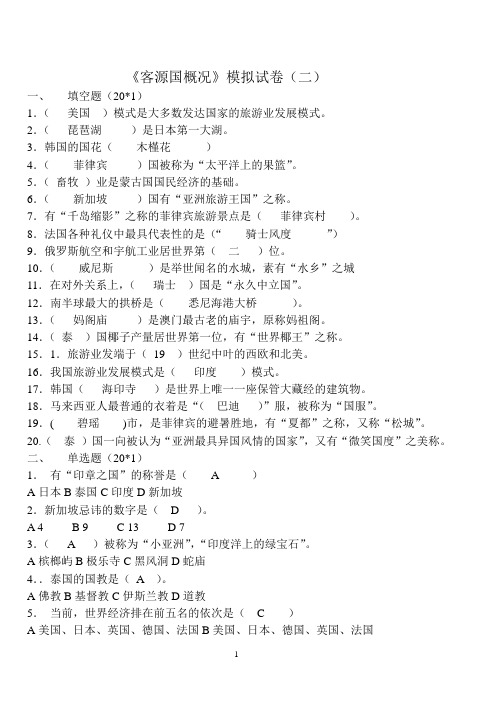
《客源国概况》模拟试卷(二)一、填空题(20*1)1.(美国)模式是大多数发达国家的旅游业发展模式。
2.(琵琶湖)是日本第一大湖。
3.韩国的国花(木槿花)4.(菲律宾)国被称为“太平洋上的果篮”。
5.(畜牧)业是蒙古国国民经济的基础。
6.(新加坡)国有“亚洲旅游王国”之称。
7.有“千岛缩影”之称的菲律宾旅游景点是(菲律宾村)。
8.法国各种礼仪中最具代表性的是(“骑士风度”)9.俄罗斯航空和宇航工业居世界第(二)位。
10.(威尼斯)是举世闻名的水城,素有“水乡”之城11.在对外关系上,(瑞士)国是“永久中立国”。
12.南半球最大的拱桥是(悉尼海港大桥)。
13.(妈阁庙)是澳门最古老的庙宇,原称妈祖阁。
14.(泰)国椰子产量居世界第一位,有“世界椰王”之称。
15.1.旅游业发端于(19 )世纪中叶的西欧和北美。
16.我国旅游业发展模式是(印度)模式。
17.韩国(海印寺)是世界上唯一一座保管大藏经的建筑物。
18.马来西亚人最普通的衣着是“(巴迪)”服,被称为“国服”。
19.( 碧瑶)市,是菲律宾的避暑胜地,有“夏都”之称,又称“松城”。
20.(泰)国一向被认为“亚洲最具异国风情的国家”,又有“微笑国度”之美称。
二、单选题(20*1)1.有“印章之国”的称誉是( A )A日本B泰国C印度D新加坡2.新加坡忌讳的数字是( D )。
A 4B 9C 13D 73.( A )被称为“小亚洲”,“印度洋上的绿宝石”。
A槟榔屿B极乐寺C黑风洞D蛇庙4..泰国的国教是(A )。
A佛教B基督教C伊斯兰教D道教5.当前,世界经济排在前五名的依次是( C )A美国、日本、英国、德国、法国B美国、日本、德国、英国、法国C美国、日本、德国、法国、英国D日本、美国、德国、法国、英国6.被称为“英国旅游中心的”是( B )A爱丁堡B伦敦C剑桥D牛津7.( B )国是西欧最大的农业生产国。
A英国B法国C德国D意大利8.俄罗斯人喜欢数字(D )。
中国客源国概况1

第一章:世界旅游客源市场
• 第一节:世界旅游业概况 • 第二节:世界旅游区概况 • 第三节:世界旅游客源市场格局及发展前 景
世界旅游业概况
• 旅游业受经济政治影响严重,一个地区的经济发 达、政治稳定,旅游业才能发展好。 • 小历史:人类旅游的起源是从1840年托马斯· 库 克,但真正大规模的发展是在第二次世界大战之后。 二战之后,西方发达国家经历了一个相对持续稳 定的发展和增长期,国际环境的相对稳定,科技 的高速发展,人们收入的提高、生活观念和消费 观念的改变,交通运输业的发达,带薪休假制度 的产生和兴起,使旅游业得到了蓬勃的发展。从 1950年开始,世界旅游业就以每年7.1%的速度 增长,1992年,世界国际国内旅游收入超过了石 油、汽车,成为世界第一大产业。
美洲的国际旅游组织:
• •
• 美洲旅行代表大会 (LATC) • 拉丁美洲旅游组织联盟 (CTOLA) • 美洲旅馆与汽车旅馆联合 会(AHMA)
• •
•
• • •
•
• • •
AH&MA 美国旅馆和汽车旅馆协会美国旅馆和汽车旅馆协会(American Hotel&Motel Association OR American Hotel & Lodging Association 简称AH&MA)总部在华盛顿,下 设八个职能部(成员关系部、政府协调部、公关部、市场销售部等)和内华 达分部,还有协会的信息中心、教育研究所、杂志社、印刷厂以及两个专业 委员会(国际会议协会,饭店销售协会)、美国饭店基金会(AHF),在美 国50个州设有分会,有的州称之饭店与餐馆协会,现有会员1万多个酒店和餐 馆,300多个国际会员。 协会的主要工作是: (1)指导地方协会工作。每年对新会员进行3天(5月份)的免费入门 培训,提供地方协会高级行政人员奖学金(每年10名,由美国饭店基金会提 供资助)。 (2)交流信息。每两个月出一期协会简讯,每月出一期杂志,介绍成员 的经营情况和总部的工作安排;在72小时内提供成员需要的有关政府法令、 顾客动态、财务评价、施行社简况等方面的信息。协会信息中心建有信息库, 可以回答25000个有关雇工权利、市场营销、风险管理等方面的疑问。 (3)促进成员之间的合作。协会保证每个会员与另外700个会员建立联 系。 (4)发展新会员。对机关报发展的会员发放认可证。对介绍酒店不少于 500间客房入会的地方协会给以1993美元的奖励。 (5)争取会员集体折扣。会员之间住店可以折扣,联合有关饭店用品的 厂家对会员购货给折扣,联合信用卡公司对会员提供折扣。 (6)组织出书和讲习班,发行录像带。如饭店旅馆协会与美国防火协会 合作,向会员提供全国防火协会的教育资料,开办防火安全讲习班。 (7)举办一年两次的美国饭店用品博览会。每年4月1日在芝加哥,11 月1日在纽约,共有7000家饭店、3000家餐馆参加。 (8)参与全国的、州的和地方的立法过程,为饭店行业说话。 协会的经费来源主要是四个方面:会费(饭店每年每个床位3美元),出书、 博览会、企业赞助收入。美国饭店基金会每年把600万美元的捐赠投资在相关 的奖学金和教育资助等方面。
客源国概况复习资料及习题
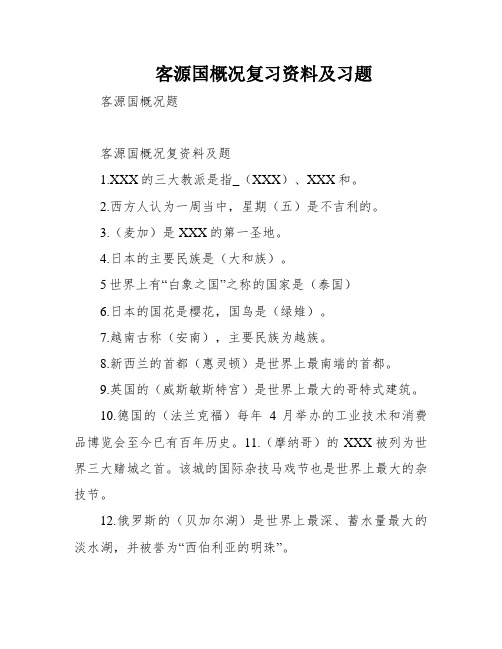
客源国概况复习资料及习题客源国概况题客源国概况复资料及题1.XXX的三大教派是指_(XXX)、XXX和。
2.西方人认为一周当中,星期(五)是不吉利的。
3.(麦加)是XXX的第一圣地。
4.日本的主要民族是(大和族)。
5世界上有“白象之国”之称的国家是(泰国)6.日本的国花是樱花,国鸟是(绿雉)。
7.越南古称(安南),主要民族为越族。
8.新西兰的首都(惠灵顿)是世界上最南端的首都。
9.英国的(威斯敏斯特宫)是世界上最大的哥特式建筑。
10.德国的(法兰克福)每年4月举办的工业技术和消费品博览会至今已有百年历史。
11.(摩纳哥)的XXX被列为世界三大赌城之首。
该城的国际杂技马戏节也是世界上最大的杂技节。
12.俄罗斯的(贝加尔湖)是世界上最深、蓄水量最大的淡水湖,并被誉为“西伯利亚的明珠”。
13.意大利的诗人(XXX)与英国的XXX和德国的XXX 并称为西欧文学史上的三大天才巨匠。
14.西班牙旅行业的王牌工程3“S”指的是阳光、(海滩)和陆地。
15.美国第二大城市(芝加哥)_是该国最大的钢铁工业基地。
16.(尼日利亚)拥有上百个民族,是世界上民族最多、最复杂的国家之一,有“民族马塞克”、“文化大拼盘”之称。
17.印度尼西亚和菲律宾的国花都是(毛茉莉)。
18.新加坡的行政用语是英语,国语是(马来语)。
19.南非最大城市、世界最大的产金中央是(约翰内斯堡)。
20.中国在美洲的主要客源国是(美国)和加拿大。
21.东亚太地区旅游组织的英文缩写是(PATA)。
22.(红场)是俄罗斯首都莫斯科市中心的著名广场,位于莫斯科市中心,西南与克里姆林宫相毗连。
原是前苏联重要节日举行群众集会和阅兵的地方。
23.(法国)的干鲜奶酪世界闻名,有“奶酪王国“之誉。
24.座落在巴黎市中央的(卢浮宫)是环球注目标艺术殿堂和万宝之宫。
也是法国最大的博物馆。
26.印度的(泰姬陵)是伊斯兰修建艺术的明珠,世界七大修建奇迹之一27.东京是日本第一大城市,而(大阪)是其第二大城市。
中国主要旅游客源国概况智慧树知到期末考试章节课后题库2024年海南经贸职业技术学院
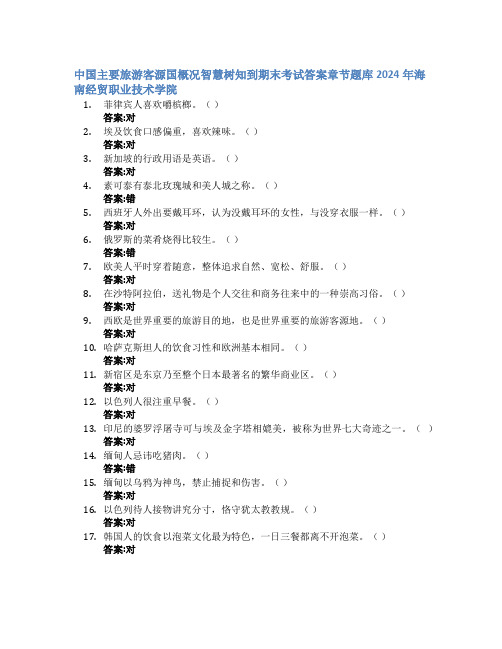
中国主要旅游客源国概况智慧树知到期末考试答案章节题库2024年海南经贸职业技术学院1.菲律宾人喜欢嚼槟榔。
()答案:对2.埃及饮食口感偏重,喜欢辣味。
()答案:对3.新加坡的行政用语是英语。
()答案:对4.素可泰有泰北玫瑰城和美人城之称。
()答案:错5.西班牙人外出要戴耳环,认为没戴耳环的女性,与没穿衣服一样。
()答案:对6.俄罗斯的菜肴烧得比较生。
()答案:错7.欧美人平时穿着随意,整体追求自然、宽松、舒服。
()答案:对8.在沙特阿拉伯,送礼物是个人交往和商务往来中的一种崇高习俗。
()答案:对9.西欧是世界重要的旅游目的地,也是世界重要的旅游客源地。
()答案:对10.哈萨克斯坦人的饮食习性和欧洲基本相同。
()答案:对11.新宿区是东京乃至整个日本最著名的繁华商业区。
()答案:对12.以色列人很注重早餐。
()答案:对13.印尼的婆罗浮屠寺可与埃及金字塔相媲美,被称为世界七大奇迹之一。
()答案:对14.缅甸人忌讳吃猪肉。
()答案:错15.缅甸以乌鸦为神鸟,禁止捕捉和伤害。
()答案:对16.以色列待人接物讲究分寸,恪守犹太教教规。
()答案:对17.韩国人的饮食以泡菜文化最为特色,一日三餐都离不开泡菜。
()答案:对18.寺庙是泰国人公认的神圣的地方,穿着必须端庄整洁,绝对不可爬上佛像拍照,或对佛像做出失敬的动作。
()答案:对19.在英国,进入餐厅后,要先站在门口等服务员领位,如果直接走到座位上,会遭到服务员鄙视。
点餐时,服务员将菜单交给客人后便会离开,直到客人合上菜单,才会再过来,如果不合上,那服务员便一直不过来。
()答案:对20.英国人的早餐很丰盛,素有“big breakfast”美称,晚餐对英国人来说也是日常生活中最重要的一部分,()答案:对21.以色列人在饮食方面没有严格的规定。
()答案:对22.克里姆林宫是俄罗斯联邦的政治中心,现代俄罗斯总统府及国家杜马所在地,是世界闻名的建筑群,享有“世界第八奇景”的美誉。
客源国概况
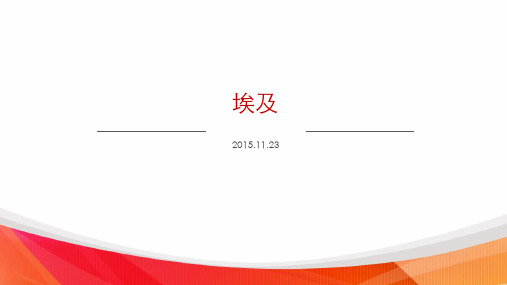
体育
埃及很重视足球运动,它普及较广,深受人们喜爱。足球的各级比赛接连不 断,每年举办1次俱乐部之间的甲、乙、丙3级联赛。甲级足球队联赛始于1948年 ,共举行过18届比赛。 足球杯赛始于1921年,此后每年举办1 次,所有俱乐部和其他代表队均可参 加比赛。此外,埃及还参加一些国际足球比赛,如非洲运动会、非洲杯、世界杯 和奥林匹克预选赛。游泳在埃及更为普及,景色宜人的地中海海滨和风景秀丽的 尼罗河畔是广阔的天然游泳场,这是埃及游泳普及的重要因素。埃及游泳水平在 非洲是较高的。1973年举行的第2届非洲运动会,埃及选手夺取了几乎全部游泳项 目的冠军。埃及又以长距离游泳著称,在横渡英吉利海峡和国际长距离游泳比赛 中曾取得良好成绩。排球运动在埃及也是一项群众性较广的体育活动,在全国150 个俱乐部里,都有排球活动,参加活动的人数仅次于足球,居全国第2位。
地理位置
埃及地跨亚、非两洲,大部分 位于非洲东北部。苏伊士运河东的 西奈半岛位于亚洲西南角。西连利 比亚,南接苏丹,东临红海并与巴 勒斯坦接壤,北濒地中海,东南与 约旦、沙特阿拉伯相望海岸线长 2700多千米。全境96%为沙漠。最 高峰为凯瑟琳山,海拔2642米。尼 罗河纵贯南北,注入地中海,境内 长1530千米,两岸形成宽约3~16 千米的狭长河谷;入海处形成2.4 万平方千米的三角洲,99%的人口 聚居在仅为国土面积4%的河谷和 三角洲地带。
政治
1971年9月11日经公民投票通过的永久宪法,规定埃及是 “以劳动人民力量联 盟为基础的民主和社会主义制度的国家”,经济上“国家所有制、合作社所有制和 私人所有制”三种形式并存;总统是国家元首、武装部队最高统帅;总统由人民议 会提名,公民投票选出。 1980年5月22日经公民投票修改宪法,规定政治制度“建立在多党制基础上” ;“总统可多次连选连任”,并增加了“建立协商会议”的条款。人民议会是最高 立法机关。议员由普选产生;议长、副议长每年选举1次。主要职能是:提名总统 候选人;主持制订和修改宪法;决定国家总政策;批准经济和社会发展计划及国家 预算、决算;对政府进行监督。
中国客源国概况作业.docx

亚洲
区位
国名
概况
主要景点
备注
东
亚
日本
首都:东京亚洲经济大国
富士山
Fuji Mountain
“富士八峰”、“富士五湖”
日本“圣山”和民族象征
东京都Tokyo
国会议事堂、赤坂离宫、东京铁塔、上野公园、上野动物园
东京铁塔为东京最高点;
京都Kyoto①
古城平安京②、东本愿寺、西本愿寺、三十三间堂③、东寺、岚山风景区④、琵琶湖⑤
美
洛杉矶
Los Aangeles
好莱坞①、迪士尼游乐园
印度尼西亚
首都:雅加达
"万岛之国"
雅加达Jakarta
①
民族纪念碑、雄牛广场
②、“迷你公园”、
1印尼和东南亚最大城市;
2雄牛被视为力量和干预斗争的象征;
万隆Bandung
覆舟火山、万隆温泉、火山博物馆、达哥瀑布
印尼第三大城市;被誉为印尼最美丽的城市;
日惹Jogjakarta
婆罗浮屠①、印度教巴玛南神庙、王家陵墓等
Budapest
布达、盖尔莱特山、佩斯、英雄广场、国会大厦、多瑙河及其岛屿
巴拉顿湖
Lake Balaton
波兰
首都:华沙
“欧洲地理中心”
华沙Warsaw,格但斯科、索波特和什切青、托伦、奥尔什丁、克拉科夫①、扎克帕内、克雷尼查、比亚沃维耶炸森林区
①被誉为波兰文化首都;
北
欧
挪威
首都:奥斯陆
“极地之国”
①土耳其古都、最大的城市和港口、最大的跨周城市、古“丝绸之路”终点;②以“蓝色清真寺”闻名于世,
世界唯一的六塔清真寺;
埃及
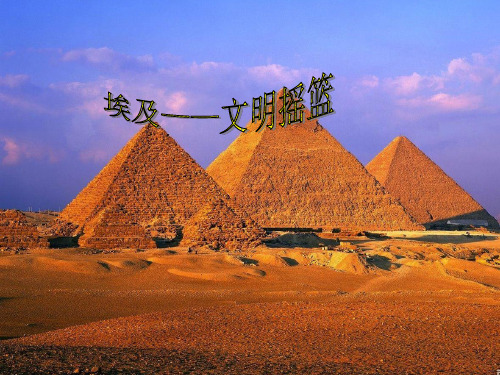
埃及——文明摇篮
一、国旗、国徽、国花
• 埃及的国旗自上而下由红、白、黑三个
平行相等的横长方形组成,白色部分中 间有国徽图案,其中红色象征革命,白 色象征纯洁和光明前途,黑色象征埃及 过去的黑暗岁月。国歌是《阿拉伯埃及 共和国国歌》。 • 国徽为一只金色的鹰,称萨拉丁雄鹰。 • 国花是睡莲。
主要客源国概况
主要客源国概况
埃及——文明摇篮
• (二)经济概况 • 埃及是一个以农业为主的国家,三分之一以 上的职业人口从事农业。耕地面积仅占国土 的4.5%,绝大部分为灌溉地,耕作集约,年 可二熟或三熟,是非洲单位面积产量最高的 国家。主产长绒棉和稻米,产量均居非洲首 位,玉米、小麦居非洲前列,还产甘蔗、花 生等。埃及非洲重要的石油和磷灰石开采国, 炼油工业发达,其他重要工业部门有食品、 纺织、化工、钢铁、机械等。尼罗河和沿海 盛产鱼类。
埃及——文明摇篮
主要客源国概况
主要客源国概况
埃及——文明摇篮
三、气候特征
• 全境干燥少雨,尼罗河三角洲和北部沿海地区属
亚热带地中海式气候,1月平均气温12℃,7月 26℃;年均降水量50~200毫米。其余大部地区 属热带沙漠气候,炎热干燥,气温可达40℃。 年平均降水量不足50毫米。每年4~5月间常有 “五旬风”,夹带沙石,损坏农作物。
主要客源国概况
埃及——文明摇篮
• 此外,埃及还有独立日、开斋节、共和国
独立日、穆罕默德诞辰日、人民抵抗纪念 日、穆罕默德升天日等节日。
主要客源国概况
埃及——文明摇篮
六、货币汇率、时差电话
• 埃及货币为埃及镑,人民币100元可以
兑换80埃及镑。 • 埃及首都开罗的时间比北京时间晚6个 小时,国际电话代码是0020,急救电话 是122。
作业1 客源国概况(双语)埃及
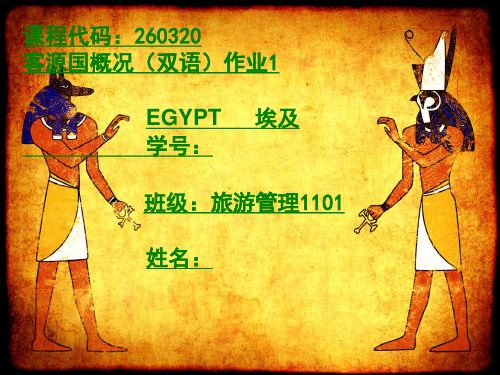
Geography
Egypt lies primarily between latitudes 22° and 32°N, and longitudes 25° and 35°E. At 1,001,450 square kilometers (386,660 sq mi),it is the world's 30th-largest country. Nevertheless, due to the aridity of Egypt's climate, population centres are concentrated along the narrow Nile Valley and Delta, meaning that about 99% of the population uses only about 5.5% of the total land area.98% of Egyptians live on 3% of the territory.
Education
According to the Webometrics Ranking of World Universities, the top-ranking universities in Egypt are Cairo University (1203rd worldwide), American University in Cairo (1306th) and Mansoura University (1712th).[188] QS World University Rankings for 2013 top-ranking universities in Egypt are American University in Cairo (348 worldwide), Cairo University (551-600) and Ain Shams University (601-650).
中国旅游客源地与目的地概况-中国旅游客源地和目的地概况课件-埃及

3.尼罗河(The Nile)
• 发源于埃塞俄比亚高原,全 长6700公里,是非洲第一 大河,也是世界上第二条最 长的河流,
(二)人文概况
(二)饮食文化
• 埃及饮食带有浓郁的 北非色彩和阿拉伯风 情。埃及菜以烧烤煮 拌为主,多用盐、胡 椒、辣椒、咖喱粉、 孜然、柠檬汁调味, 口感偏重。喜欢吃焖 蚕豆、烤羊肉和油烙 面饼,特别喜欢吃甜 食,最喜爱的饮料是 红茶、咖啡和鲜柠檬 水等。吃饭习惯用右 手抓食。
(三)旅游纪念品
1. 纸莎草纸
• 纸莎草是尼罗河 三角洲生长的一 种类似芦苇的水 生莎草科植物, 可以用来造纸, 再由传统画师用 纸莎草笔精心绘 制。纸莎草是古 埃及文明的一个 重要组成部分, 埃及文化瑰宝的 、世界上最早的 纸画!
2. 香水和香料
• 埃及香料的品种繁多, 功能各异,象麝香、 玫瑰、荷花香精等是 专门制作香水用的, 开罗作为世界上最大 的香料贸易中心和香 精供应商之一,已经 有1000多年的历史。
Antiquities
• 坐落在开罗市中心的解 放广场,1902年建成开 馆,是世界上最著名、 规模最大的古埃及文物 博物馆。该馆收藏了 5000年前古埃及法老时 代至公元六世纪的历史 文物25万件,其中大多 数展品年代超过3000年。
(二)亚历山大Alexandria
• 临地中海, 人口305万, 是埃及和非洲第二大城 市,也是埃及和东地中 海最大港口。该城建于 公元前332年,因希腊 马其顿国王亚历山大大 帝占领埃及而得名,是 古代和中世纪名城, 亚历山大风景优美,气 候宜人,是埃及的“夏 都”和避暑胜地,被誉 为“地中海新娘忌要提醒游客注意?
埃及英文简介
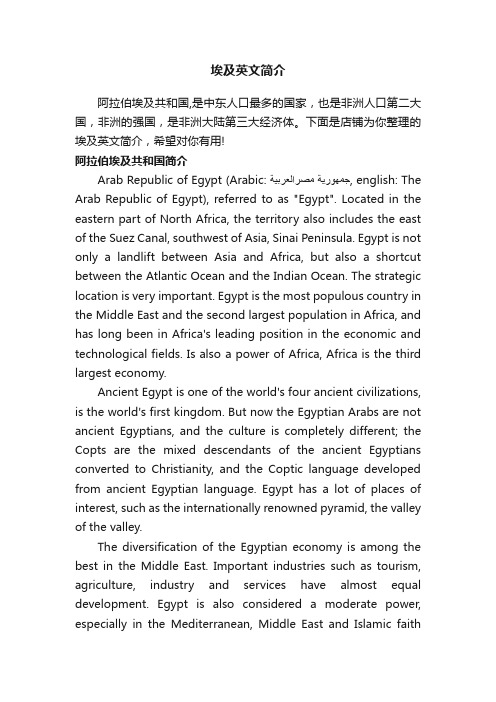
埃及英文简介阿拉伯埃及共和国,是中东人口最多的国家,也是非洲人口第二大国,非洲的强国,是非洲大陆第三大经济体。
下面是店铺为你整理的埃及英文简介,希望对你有用!阿拉伯埃及共和国简介ةيبرعلارصم, english: The Arab Republic of Egypt (Arabic: ةيروهمجArab Republic of Egypt), referred to as "Egypt". Located in the eastern part of North Africa, the territory also includes the east of the Suez Canal, southwest of Asia, Sinai Peninsula. Egypt is not only a landlift between Asia and Africa, but also a shortcut between the Atlantic Ocean and the Indian Ocean. The strategic location is very important. Egypt is the most populous country in the Middle East and the second largest population in Africa, and has long been in Africa's leading position in the economic and technological fields. Is also a power of Africa, Africa is the third largest economy.Ancient Egypt is one of the world's four ancient civilizations, is the world's first kingdom. But now the Egyptian Arabs are not ancient Egyptians, and the culture is completely different; the Copts are the mixed descendants of the ancient Egyptians converted to Christianity, and the Coptic language developed from ancient Egyptian language. Egypt has a lot of places of interest, such as the internationally renowned pyramid, the valley of the valley.The diversification of the Egyptian economy is among the best in the Middle East. Important industries such as tourism, agriculture, industry and services have almost equal development. Egypt is also considered a moderate power, especially in the Mediterranean, Middle East and Islamic faithareas.Although Egypt has a strong influence in Africa and the Middle East, Egypt's economy is not optimistic, most of the country is relatively poor. Especially since the beginning of 2011, the turbulent situation on the national economy caused a serious impact.Egyptian birth rate is very high, which led to about 10 million people are not registered, the European experts estimate that the Egyptian population may have more than 100 million.The official language of Egypt is Arabic. For historical reasons, English and French are also widely used in Egypt.阿拉伯埃及共和国历史沿革Egypt is one of the four ancient civilizations. In 3100 BC there was a unified slavery country, and ancient Egypt continued to form 31 dynasties. BC 11th century to the first century, intermittently by Assyria, Babylon, Persia, ancient Macedonia and the Roman Empire conquered.AD 4-7 century into the Eastern Roman Empire, the ancient Egyptian civilization destroyed. After the Persian Sassan dynasty occupied. In the middle of the 7th century, the Arabs invaded as part of the Arab Empire.At the end of the Arab Empire, Egypt appeared in the Fatima dynasty and the Ayuba dynasty.1249 began by the Ma Lu Luke dynasty rule, 1517 was Ottoman Turkey conquered, became the Ottoman Empire of Egypt province.1798 ~ 1801 was once occupied by Napoleon. 1805 ~ 1840 under the leadership of Muhammad Ali into a brief independence.1882 was occupied by the British army, in 1914 became theBritish protectorate.February 28, 1922, the British were forced to recognize Egypt's independence, but still retain the right to defense, diplomacy, ethnic minorities, the Egyptian authorities are still under the control of the British puppet dynasty, according to the British government agreement between Britain can at any time to protect The British sent troops to Egypt in Egypt.In 1952, Nasser led the "free military organization" launched a military coup, overthrow the Farooq dynasty, set up a "revolutionary steering committee", master the state power, get real independence. June 18, 1953 abolished the monarchy, the establishment of the Republic.In 1954, the British were forced to agree to withdraw troops from Egypt in batches until 1956, when all the British troops withdrew from Egypt, but remained in the Suez Canal area.In 1956, Nasser took the Suez Canal as state, led to the second Middle East war, the British and France, Israel formed a coalition, assault control of the Sinai Peninsula and Suez Canal area, surrounded by the Egyptian army, and Egypt's large The city launched a strategic bombardment to deter Egyptian civilians. Egypt was bombed more than 10,000 houses, killing more than 1,000 people, injured more than 20,000 people. After the war in Egypt to lay its leadership position in the Middle East; Britain also recognized the actual strength of the upper and lower, declared "withdrawal from the east of the Suez Canal", to give up on Singapore, Malaya, Kuwait, Bahrain, Kenya, Tanzania and other places of colonization rule.In February 1958, Egypt and Syria merged to form the United Arab Republic. In September 1961, Syria was divorced from the United Arab Republic. In 1967, the third Middle East war brokeout, Egypt lost the Sinai Peninsula.In 1970, Nasser died, led by President Sadat. In September 1971, the country was changed to "the Arab Republic of Egypt".In 1978, Egypt signed a peace treaty with Israel. In 1981, Sadat was assassinated and killed by Muhammad Hosni Mubarak. The sovereignty of the Sinai Peninsula in 1982.The jasmine revolution in 2011, the social unrest in the Arab world, and the anti-government demonstrations of "fighting for democracy, anti-dictatorship and anti-corruption" surged. Egypt became an important scene in this drama, the movement led to the ruling three decades of President Mubarak sadly step down, and by the military to master the national transition regime. In June 2012, the elected president Muhammad Mursi came to power, a year later he was dismissed by the military, after the Mu brothers will lead to protest protest and serious bloody conflict, the Egyptian society is also facing a serious split and opposition situation.On June 3, 2014, Abdul Fatah Sessions was elected President and was sworn in on 8 June.On October 28, 2016, Egypt was elected a member of the United Nations Human Rights Council for a term of office from 2017 to 2019.。
- 1、下载文档前请自行甄别文档内容的完整性,平台不提供额外的编辑、内容补充、找答案等附加服务。
- 2、"仅部分预览"的文档,不可在线预览部分如存在完整性等问题,可反馈申请退款(可完整预览的文档不适用该条件!)。
- 3、如文档侵犯您的权益,请联系客服反馈,我们会尽快为您处理(人工客服工作时间:9:00-18:30)。
班级:旅游管理1101
姓名:
It's EGYPT
亚非分界线
Egypt's geographical location, is located in northeast
Africa, and across Asia, the two states. West and Libya's neighbors, southern border with Sudan, the red sea in the east and bordering on Palestine, Israel, north near the Mediterranean Sea The Suez Canal is located in Egypt, is connected the Asian and the main international shipping lanes on three continents.
Geography Towns and cities include Alexandria, the second largest city; Aswan; Asyut; Cairo, the modern Egyptian capital and largest city; El-Mahalla El-Kubra; Giza, the site of the Pyramid of Khufu; Hurghada; Luxor; Kom Ombo; Port Safaga; Port Said; Sharm ห้องสมุดไป่ตู้l Sheikh; Suez, where the south end of the Suez Canal is located; Zagazig; and Al-Minya. Oases include Bahariya, el Dakhla, Farafra, el Kharga and Siwa. Protectorates include Ras Mohamed National Park, Zaranik Protectorate and Siwa.
Economy
The government has invested in communications and physical infrastructure. Egypt has received United States foreign aid since 1979 (an average of $2.2 billion per year) and is the third-largest recipient of such funds from the United States following the Iraq war. Egypt’s economy mainly relies on these sources of income: tourism, remittances from Egyptians working abroad and revenues from the Suez Canal.
Politics
Egypt has the oldest continuous parliamentary tradition in the Arab world.[98] The first popular assembly was established in 1866. It was disbanded as a result of the British occupation of 1882, and the British allowed only a consultative body to sit. In 1923, however, after the country's independence was declared, a new constitution provided for a parliamentary monarchy.
Society History
There is evidence of rock carvings along the Nile terraces and in desert oases. In the 10th millennium BC, a culture of hunter-gatherers and fishers was replaced by a grain-grinding culture. Climate changes or overgrazing around 8000 BC began to desiccate the pastoral lands of Egypt, forming the Sahara. Early tribal peoples migrated to the Nile River where they developed a settled agricultural economy and more centralized society.
Economy
Egypt's economy depends mainly on agriculture, media, petroleum imports, natural gas, and tourism; there are also more than three million Egyptians working abroad, mainly in Saudi Arabia, the Persian Gulf and Europe. The completion of the Aswan High Dam in 1970 and the resultant Lake Nasser have altered the time-honored place of the Nile River in the agriculture and ecology of Egypt. A rapidly growing population, limited arable land, and dependence on the Nile all continue to overtax resources and stress the economy.
Egypt, about 2900 kilometers of coastline, but it is a
typical desert country, 95 percent throughout the desert. The Nile Delta and the northern coastal area is a Mediterranean-type climate, in January the average temperature of 12 ℃, 7 Yue 26 ℃; annual average precipitation is 50-200 mm. Most of the remaining area is a tropical desert climate, hot and dry, desert regions temperatures can reach 40 ℃, annual average precipitation is less than 30 mm.
Tourism is one of the most
important sectors in Egypt's economy. More than 12.8 million tourists visited Egypt in 2008, providing revenues of nearly $11 billion. The tourism sector employs about 12% of Egypt's workforce.[143] Tourism Minister Hisham Zaazou told industry professionals and reporters that tourism generated some $9.4 billion in 2012, a slight increase over the $9 billion seen in 2011.
Geography
Egypt lies primarily between latitudes 22° and 32°N, and longitudes 25° and 35°E. At 1,001,450 square kilometers (386,660 sq mi),it is the world's 30th-largest country. Nevertheless, due to the aridity of Egypt's climate, population centres are concentrated along the narrow Nile Valley and Delta, meaning that about 99% of the population uses only about 5.5% of the total land area.98% of Egyptians live on 3% of the territory.
Education
According to the Webometrics Ranking of World Universities, the top-ranking universities in Egypt are Cairo University (1203rd worldwide), American University in Cairo (1306th) and Mansoura University (1712th).[188] QS World University Rankings for 2013 top-ranking universities in Egypt are American University in Cairo (348 worldwide), Cairo University (551-600) and Ain Shams University (601-650).
